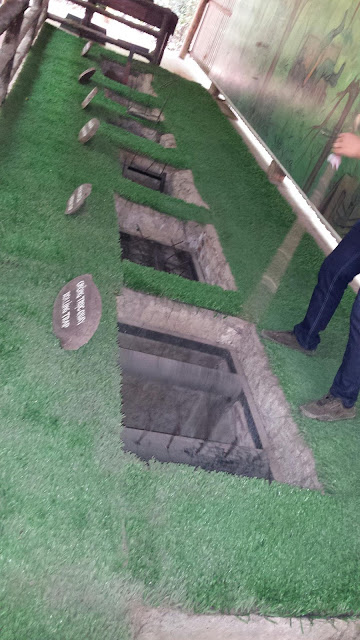We began a day tour through Luxury Group Travels, at 8am. We were pleased to see the tour guide how came to get us was Nhan , the same guide we had the previous day for the Mekong Delta tour.
Our first stop was at a location where disabled people produced lacquer products. Many of the workers had disabilities related to the war - most frequently agent orange deformaties.
Nhan explained the tunnels were started in 1948 during the French Revolution and most homes had hiding tunnels. When the US came to destroy Vietnam in 1964 the area where the tunnels are was identified as housing Revolutionaries. The Vietnamese people in this area began to link the existing tunnels in the homes and eventually joined 6 villages together. There are 213 kms of tunnels. The tunnels were dug with hand tools in clay. The dirt/clay removed was either dumped in the mekong river or bomb craters to hide evidence of tunneling.
Generally the tunnels had three levels. The first level was for living - sleeping, meeting, cooking, hospital care rooms. The second lower level was for transportation and moving from level one rooms. The lowest level was for escaping. The low level tunnels connected with the river and into a hill.
The cooking was done once a day in the early morning to allow the smoke to blend in with the fog. A system was used to move the smoke through small chambers and exit away from the cooking area.
The latrine was the lowest tunnel at the Mekong river. At one time 1,600 people lived in these tunnels. When the US attempted to flood the tunnels it forced rodents and bugs farther down the tunnels. This provide additional food supplies for those in the tunnels and they still had escape routes into higher ground.
Air vents were disguised as termite nests. A stick of bamboo was placed into a termite nest and driven deep into the ground. The termites ate the inside of the bamboo leaving a thin chamber for air.
During the vietnam war the US dropped 1/2 ton of agent orange. The Vietnamese people needed to learn to cook without smoke, walk without tracks. The Vietnamese people made sandals out of recycled car tires which left foot prints going the opposite direction they really were.
The exhibits at Cu Chi tunnels also showed some of the booby traps the Vietnamese used - in the tunnels and on the ground. We got to taste tapioca roots dipped in salt. The opportunity to shoot military guns such as bazooka, AK47'S, etc was offered. You had to purchase a minimum amount of rounds. We declined.
Touists are able to go into an area of tunnels. The tunnels have been widened for tourists. Tourists can choose to go 15, 30, 45 meters or longer. The tunnels get smaller as the distance progresses, however even the first tunnel requires crouching or for the tall people crawling.
After the tunnels we were dropped off at the War Remnants Museum. The first section was called Historical Truths and explained vietnams history in the wars.
The second section was a collection of photos taken from 134 journalists of 12 different nationalities killed during the Indochina War. These pictures difficult to look at. Very raw, real - included was the napalm girl picture that was featured in the Time magazine.
The third section was documentary photos of Japan photographers during the war. Fourth section - imprisonment conditions during the war, including US acknowledgement of committing war atrocities. A display of guns, bombs and other weapons. Fifth section was called aggressive war crimes and showed the long lasting effects war injuries - physical and emotional and the use of agent orange. Birth defects showing up in the third generation. The museum even had exhibits of deformed fetuses.
The last section was the world's people in support of vietnam ' s resistance. Our side the museum was a display of US large weapons, planes and tanks




























No comments:
Post a Comment